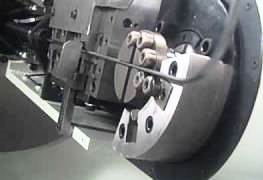 For many decades, the wireforming industry was limited to the use of manual labor to accomplish most tasks. Even after the introduction of early computerized wireforming equipment, many companies continued to rely on the use of manual labor for most tasks.
For many decades, the wireforming industry was limited to the use of manual labor to accomplish most tasks. Even after the introduction of early computerized wireforming equipment, many companies continued to rely on the use of manual labor for most tasks.
Early wireforming robots that were controlled by computer were prohibitively expensive for the productivity enhancements that they offered. However, as time went on, these machines became more and more sophisticated, allowing for a greater level of productivity.
Why Marlin Adopted the Computerized Equipment that Revolutionized the Wireforming Industry
For decades, Marlin Steel was a company that relied heavily on manual labor for basic wireforming tasks. Employees would work for hours on end, manually bending lengths of steel wire by hand, with each employee completing about 20-30 steel wire baskets in a day if they were really productive.
It was exhausting, backbreaking, dangerous work that left workers physically drained, and frequently injured. Things wouldn’t change until after the company was moved to Baltimore in 1998 and faced with the threat of extinction if it couldn’t find a way to improve productivity and consistency in its manufacturing process.
After losing most of its bagel industry customers in the late nineties to a combination of:
-
Low-carb diets that forced many bagel companies out of business; and
-
Super-cheap commodity baskets flooding the market from government-subsidized Chinese steel companies who could sell baskets for less than the cost of the steel used to make them
Marlin Steel was forced to evolve as a custom stainless steel basket maker and find new industries to serve, ones where quality and speed would trump cost.
However, to serve industries that have high quality and parts tolerance requirements, Marlin needed to move beyond its former reliance on manual labor. Even a highly-skilled wire bending worker can only complete bends so quickly, and the faster such a worker goes, the less likely it is that the bends they make will all be able to meet millimeter-precise tolerances.
This is part of the reason why Marlin Steel chose to adopt the use of computer-controlled wire bending robots in its production processes.
How Marlin Uses Computerized Wireforming Equipment On the Factory Floor
Initially, Marlin Steel faced many challenges in integrating the wire bending robots that are now an integral part of the company’s manufacturing process. It took time to get used to the capabilities of the wire bending robots and discover how to take advantage of those capabilities to the fullest.
For example, employees had to be trained in the use of these machines, and processes had to be altered to accommodate the increased production.
However, Marlin was committed to adopting this technology and making the most out of the investment while protecting employees, rather than using the excess capacity to try and replace them.
When the steel wire bending robots were introduced to Marlin’s production line, the employees that once worked at bending wires manually were offered training in the use of the wire bending machines.
Using the wireforming robots, these employees moved from being manual laborers to being supervisors of automated labor. Now, these workers were using their brains rather than their brawn.
Benefits of Using Manufacturing Automation
Since adopting the computer-controlled wire bending technology, Marlin Steel has noticed several benefits, including:
-
Reduced Injuries. When workers were bending and cutting wires by hand, injuries were common. Suddenly springing metal could sever fingers, and some workers even lost eyes to flying bits of metal. Using mechanical assistance for wire bending tasks improved safety immensely. Recently Marlin passed the 2,500-day mark for consecutive days without a lost-time safety incident.
-
Improved Productivity. Wire bending robots can work with greater speed, accuracy, and consistency than human workers. A human worker going all-out might be able to complete as many as 30 steel wire baskets a day. However, working as such speed is tiring, and precision suffers. Computer-controlled robots, on the other hand, don’t get tired. Each bend, from the first to the last, is made with exacting precision. Plus, a machine can make dozens of wire bends in a minute, compared to the 5-8 bends a human worker might be able to make at peak efficiency.
-
Reduced Parts Rejections/Scrap. Because each bend is made with greater consistency, the chances of a given piece of wire being rejected and having to be reworked or replaced is greatly reduced. This reduces production scrap, and makes completing orders even faster by eliminating delays.
Overall, Marlin’s adoption of the computer controlled wireforming equipment that revolutionized the industry has greatly enhanced the company’s production capabilities.
Without computerized manufacturing equipment such as its wire bending robots and automated welding machines, Marlin would not be able to deliver on its promise of “Quality, engineered quick” as reliably as it does.
Thanks to automated manufacturing equipment, and Marlin’s investments in employee training to make the most of it, Marlin’s sales have grown immensely since 1998, and the company now employs twice as many workers as it did back then.



.gif)


